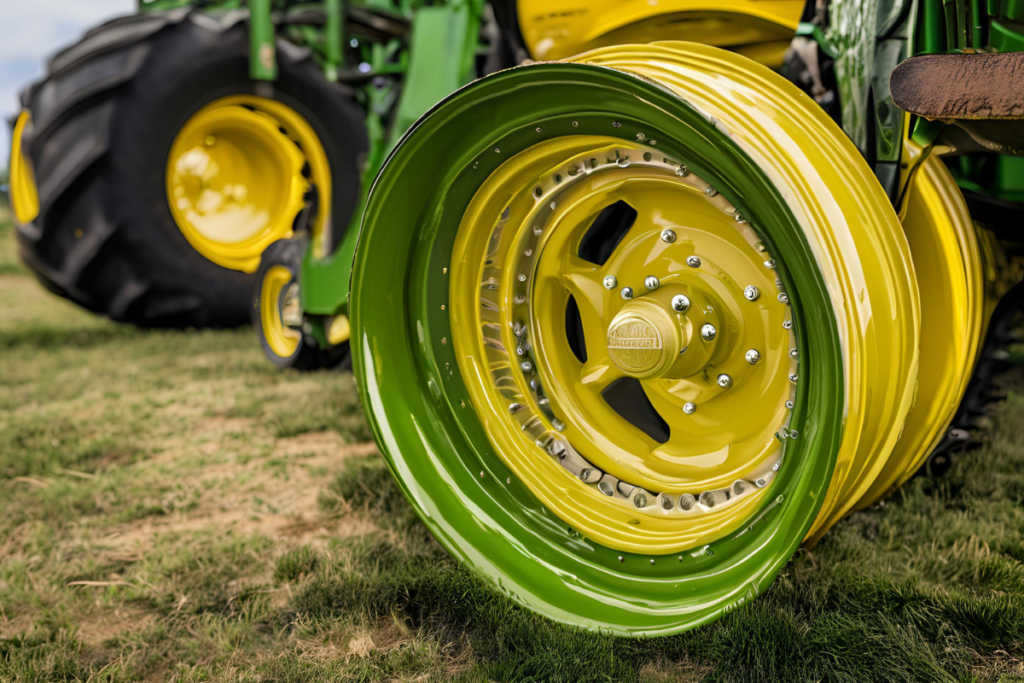Guide to John Deere Tractor Rims: Types, Features, and Installation Tips

When it comes to maintaining or upgrading your John Deere tractor, choosing the right rims plays a crucial role in performance, stability, and overall functionality. Whether you’re replacing old rims or customizing your tractor for specific tasks, understanding the various types of rims available is essential.
In this guide, we’ll cover everything you need to know, from rim types to purchasing options, installation, and maintenance.
The Importance of Choosing the Right Rims
John Deere tractors are known for their reliability and performance, but these qualities depend heavily on having the right components. Tractor rims not only support the tires but also impact the overall traction, weight distribution, and wear of your tires. Selecting the right rims for your tractor ensures optimal field performance, improved safety, and long-term cost efficiency.
Types of John Deere Tractor Rims Available
- Outer Rims:
- 18 x 38 Outer Rims: New and unused rims featuring 8 evenly spaced holes. These rims are commonly used for larger tractors and offer solid performance.
- Heavy Duty Ringa Wheels: Available in sizes like 18 x 38, these rims are designed for enhanced durability, making them suitable for tough agricultural tasks.
- Solid Centre Wheels:
- 16.9 x 26 and 12 x 24 Solid Centre Wheels: These rims come with 8 studs and various center bore specifications. They are versatile and compatible with different John Deere models, offering stable performance across various terrains.
- Row Crop Wheels:
- 12.4 x 46 Row Crop Wheels: Specifically designed for John Deere tractors, these rims feature 8 studs with a 6-inch center bore. Their narrow profile makes them ideal for row crop farming, where precision and reduced soil compaction are key.
- Custom Options:
- Suppliers like Sloan Express and Agrispares Trading offer custom inquiries to meet specific wheel needs, providing a broad selection for various tractor models. Whether you require a unique size or specialized design, these options are worth exploring.
Purchasing Options for John Deere Rims
You can find John Deere tractor rims through various channels:
- Online Retailers: Websites like Deere’s official store, Sloan Express, and TractorHouse offer a wide range of new and used rims. These platforms are convenient for browsing various options, comparing prices, and reading customer reviews.
- Local Dealers: Visiting a local John Deere dealer can be beneficial if you need personalized service and expert advice on compatibility. Dealers often have specific parts in stock and can provide quick delivery and installation support.
Comparison Table: Popular Rim Models
| Rim Type | Size | Features | Best Use |
| Outer Rim | 18 x 38 | 8 evenly spaced holes, heavy-duty | Large tractors |
| Heavy Duty Ringa Wheel | 18 x 38 | Durable design | Tough agricultural tasks |
| Solid Centre Wheel | 16.9 x 26 | 8 studs, versatile | General-purpose |
| Row Crop Wheel | 12.4 x 46 | 6” center bore, narrow profile | Row crop farming |
Installation Guide
Installing rims on your John Deere tractor is a task you can handle with basic tools and a bit of mechanical know-how. Follow these steps:
- Safety First: Park your tractor on a flat surface, engage the parking brake, and place wheel chocks around the opposite tires.
- Prepare the Area: Use a hydraulic jack to lift the tractor and secure it with jack stands.
- Remove the Old Rims: Use a wrench to remove the lug nuts and gently remove the old rims.
- Install the New Rims: Align the new rims with the wheel studs, ensuring they fit correctly. Hand-tighten the lug nuts first.
- Secure the Rims: Use a wrench to tighten the lug nuts in a crisscross pattern for even distribution.
- Lower the Tractor: Carefully lower the tractor, then give the lug nuts a final check to ensure they are tight.
Maintenance Tips
To keep your John Deere tractor rims in optimal condition:
- Regular Cleaning: Clean your rims after each use, especially if you’ve been working in muddy or wet conditions.
- Check for Rust: Inspect rims regularly for signs of rust. Applying a rust-preventative spray can extend their lifespan.
- Tighten Lug Nuts: Regularly check that all lug nuts are tight to prevent loosening during operation.
- Monitor Wear and Tear: Over time, rims can develop cracks or dents. Address these issues promptly to avoid compromising tractor performance.
Conclusion
Selecting the right John Deere tractor rims can make a noticeable difference in your tractor’s performance and durability. Whether you’re in need of outer rims, solid center wheels, or row crop rims, there are plenty of options available to suit your needs. By considering factors like rim type, size, and compatibility, you can make an informed purchase that keeps your tractor operating smoothly for years to come.
With the right rims in place and proper maintenance, you can confidently tackle any agricultural task with your John Deere tractor.
